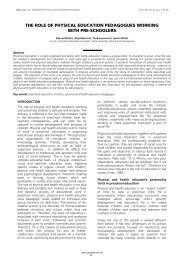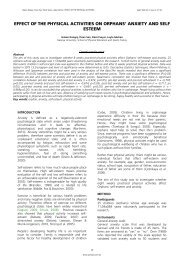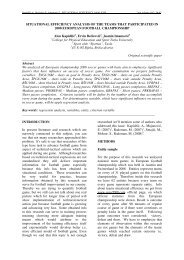The differences in some anthropometric characteristics between top ...
The differences in some anthropometric characteristics between top ...
The differences in some anthropometric characteristics between top ...
You also want an ePaper? Increase the reach of your titles
YUMPU automatically turns print PDFs into web optimized ePapers that Google loves.
Popović S., Molnar S., Mašanović B.: THE DIFERENCES IN SOME... Vol. 6 Issue 1&2: 14-19<br />
METHOD<br />
Participants<br />
<strong>The</strong> sample <strong>in</strong>cluded 56 male respondents aged<br />
28 (± 1 year) divided <strong>in</strong>to two subsamples. <strong>The</strong><br />
first subsample <strong>in</strong>cluded 25 respondents who<br />
were actively engaged at a Football Club<br />
“Vojvod<strong>in</strong>a” from Novi Sad, compet<strong>in</strong>g <strong>in</strong> the<br />
Super League of Serbia, while the other<br />
subsample <strong>in</strong>cluded 30 respondents who played<br />
sports recreationally <strong>in</strong> a place where they<br />
lived. <strong>The</strong> criteria for select<strong>in</strong>g footballers for<br />
the sample were as follows: be<strong>in</strong>g a member of<br />
the first team <strong>in</strong> the club for a year at least and<br />
hav<strong>in</strong>g a good health condition, while for the<br />
other subsample the only criterion was not<br />
play<strong>in</strong>g sports actively.<br />
Instruments<br />
For the data collect<strong>in</strong>g the technique of<br />
<strong>anthropometric</strong> <strong>in</strong>vestigation was used. 20<br />
<strong>anthropometric</strong> measures were taken altogether<br />
that def<strong>in</strong>ed longitud<strong>in</strong>al and transversal<br />
dimensionality of the skeleton, the body mass<br />
and the body volume, as well as the<br />
subcutaneous adipose tissue: body height<br />
(BODHEI), body mass (BODMAS), elbow<br />
diameter (ELBDIA), wrist diameter (WRIDIA),<br />
knee diameter (KNEDIA), ankle diameter<br />
(ANKDIA), m<strong>in</strong>imum upper arm diameter<br />
(MINUAD), maximum upper arm diameter<br />
(MAXUAD), m<strong>in</strong>imum forearm diameter<br />
(MINFAD), maximum forearm diameter<br />
(MAXFAD), m<strong>in</strong>imum thigh diameter<br />
(MINTHD), maximum thigh diameter<br />
(MAXTHD), m<strong>in</strong>imum calf diameter<br />
(MINCAD), maximum calf diameter<br />
(MAXCAD), triceps sk<strong>in</strong>fold thickness<br />
(TRSKTH), forearm sk<strong>in</strong>fold thickness<br />
(FASKTH), thigh sk<strong>in</strong>fold thickness<br />
(THSKTH), calf sk<strong>in</strong>fold thickness<br />
(CASKTH), chest sk<strong>in</strong>fold thickness<br />
(CHSKTH) and abdom<strong>in</strong>al sk<strong>in</strong>fold thickness<br />
(ABSKTH). Anthropometric research was<br />
conducted accord<strong>in</strong>g to the IBP standards<br />
respect<strong>in</strong>g the basic rules and pr<strong>in</strong>ciples related<br />
to the parameter choice, standard conditions<br />
and measurement techniques, as well as the<br />
standard measur<strong>in</strong>g <strong>in</strong>struments adjusted before<br />
measurement was carried out.<br />
Procedure<br />
<strong>The</strong> data obta<strong>in</strong>ed <strong>in</strong> the research were<br />
processed us<strong>in</strong>g the application statistics<br />
program SPSS 10.0 adjusted for the use on<br />
personal computers. Arithmetic means,<br />
standard deviation and standard errors of<br />
arithmetic means were first calculated, and then<br />
it was determ<strong>in</strong>ed whether there was<br />
significance with respect to the difference<br />
<strong>between</strong> the arithmetic means <strong>in</strong> respondents<br />
actively play<strong>in</strong>g football and the respondents<br />
play<strong>in</strong>g sports recreationally, which was done<br />
test<strong>in</strong>g the difference <strong>between</strong> the arithmetic<br />
means of <strong>in</strong>dependent samples, us<strong>in</strong>g the<br />
popularly known, t-test. <strong>The</strong> analysis provided<br />
the answers to the question of whether there<br />
was and how prom<strong>in</strong>ent was the difference<br />
<strong>between</strong> <strong>anthropometric</strong> <strong>characteristics</strong> <strong>in</strong> the<br />
<strong>top</strong> sports people, i.e. footballers and the<br />
respondents of the same age but engag<strong>in</strong>g <strong>in</strong><br />
sports on a recreational basis.<br />
RESULTS AND DISCUSSION<br />
This section offers the results of the central and<br />
dispersion parameters, as well as the results of<br />
discrim<strong>in</strong>ative analysis classified <strong>in</strong>to two<br />
tables. <strong>The</strong> first table, <strong>in</strong> the first two columns<br />
conta<strong>in</strong>s the data on basic discrim<strong>in</strong>ative<br />
parameters for the analyzed variables<br />
(Variables) and entity group (Group). <strong>The</strong> third<br />
columns shows the number of respondents <strong>in</strong><br />
both samples (N), and then the arithmetic<br />
means of both samples (M), the standard<br />
deviation (SD) <strong>in</strong> both samples (SD) and the<br />
standard errors of arithmetic means (SEM). <strong>The</strong><br />
other table conta<strong>in</strong>s all the data related to the<br />
procedure of a t-test for <strong>in</strong>dependent samples.<br />
For each variable the results of Levene's test for<br />
equality of variances are given: its value (F),<br />
and significance (p). <strong>The</strong> rema<strong>in</strong><strong>in</strong>g columns<br />
show the test results of equality of arithmetic<br />
means divide <strong>in</strong>to two groups: t-test value (t),<br />
degrees of freedom (df), the significance level<br />
of two-way test<strong>in</strong>g of the equality of arithmetic<br />
means (p), the difference <strong>between</strong> the<br />
arithmetic means (MD), the standard error of<br />
the difference (SED), the low <strong>in</strong>terval limit<br />
(M<strong>in</strong>) and upper <strong>in</strong>terval limit (Max) of the<br />
<strong>differences</strong> of p=.05.





